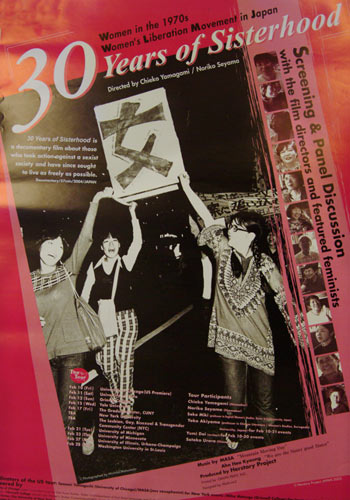30 Years of Sisterhood:
Women in the 1970's Women's Liberation Movement in Japan.

Documentary/Japan/57min/2004
Directed by YAMAGAMI Chieko/SEYAMA Noriko
Music by MASA/Ahn Hye Kyoung
Produced by Herstory Project

The interpretation of a social movement can be a notoriously difficult task for a documentarian. Participants bring unique interests, outlooks and goals to a social movement which the filmmaker must organize and cultivate into a coherent representational vision.
The documentary film, "30 Years of Sisterhood", traces the then and now of the Japanese women's liberation movement, focusing on twelve key activists who played important roles within the movement during the early 1970s. Wedding activists' interviews to a sequence of narratives, the film successfully describes some of the major events and organizational accomplishments of the movement: mass demonstrations, study groups, summer camps, and cooperative forms like the 'Lib Center'. As with any documentary, the film actively engages in the process of reconstruction and presentation, framing the movement's achievements from within a distinct interpretive lens. Nevertheless, the documentary's forceful manner bypasses certain key aspects of the movement which require analytic commentary.
The simplification engaged in by the film implies an overly tight degree of congruence between the movement's democratic ideals and its organizational structure. It is notable that the film presents the movement as an organizationally leaderless, democratic and grass-roots phenomenon, based on the consciences and desires of Japanese women to challenge the status quo and seek greater equality. The film downplays the strategic organizational roles of the twelve featured women in lieu of emphasizing their thoughts and actions as individuals. But in doing so, the film exaggerates the degree to which the movement was, in fact, a decentralized phenomenon. In reality, the women's movement struggled with the same tension between hierarchical leadership and democracy that also defined the camp of American feminists.
The film is the only documentary other than "Ripples of Change" (1993), directed by Kurihara Nanako, that offers an in-depth portrayal of the Japanese feminist movement to an international audience (the latter's content, as well as its reception, have been extensively reviewed by Linda White in Feminism Within and Beyond Japan: Women's Movements in Tokyo in 1995 [Ph.D. Dissertation, University of Colorado, 1999]). The tone of these films could not be more starkly contrasting. On the one hand, "Ripples of Change" characterizes the movement as a failed endeavor; the sacrifices made by committed activists leading only to further marginalization from a society they tried to change. On the other hand, a rosy optimism unifies "30 Years of Sisterhood". It portrays the twelve women, as well as the broader movement they represented, as heroines who paved the way for substantial social and economic improvements to be made in Japan.
The representation of history is another problematic feature of the film. The English subtitles are prosaic and overly simplify the primary statements one can find in the historical archives. Many of these archival statements are polished and poignant commentaries on the movement; the honest and complex feelings immanent to the process of constructing subjective, gendered identities from within a movement strongly focused on raising feminist consciousness. The movement's discourse, then, is both complicated and heterogeneous, but never fails to be refreshing and captivating. Yet the film, because of its one-sided optimism and overly nostalgic tone, loses the sense of urgency and the ability of its participants to manipulate language in creative and original ways which characterizes the archival sources.
Although "30 Years of Sisterhood" presents the Japanese feminist movement within a restrictive mode of documentation that selectively simplifies its historical contents, the value of the film lies more in its capacity to publicize a social movement that has, to date, received scant attention from audiences outside of Japan.


